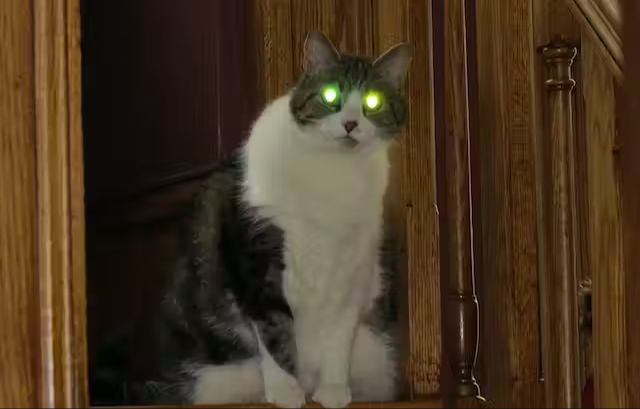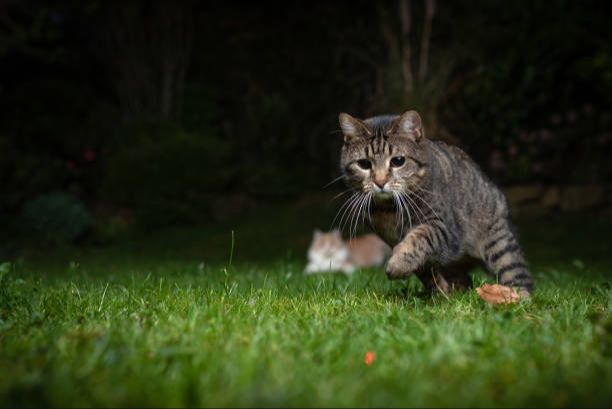Many animals are able to see well in low light conditions compared to humans. This ability is called night vision. Nocturnal animals that are active at night rely on this ability to hunt, forage and navigate in the dark. This article will examine whether cats have night vision capabilities.
The Cat’s Eye
The cat eye has several unique structures and features that allow cats to see well in low light conditions. Cats have large, rod-dominated retinas which contain a high concentration of rod cells. Rod cells are extremely sensitive to light and allow cats to see in very dim environments. Cats also have a structure called the tapetum lucidum which is a reflective layer behind the retina that bounces light back through the retina for additional stimulation of the rod cells. This further enhances their ability to see in low light. Cats also have vertically slit pupils which can open very wide to allow more light in, but also narrow to slits in bright light to prevent overstimulation.

Tapetum Lucidum
The tapetum lucidum is a layer of tissue behind the retina in cats’ eyes that reflects light back through the retina, enhancing night vision. It is a retroreflector, reflecting visible light directly back along the light path to the source. The tapetum lucidum is located in the choroid, which contains the blood supply to the retina.
Cats have a high density of rod photoreceptor cells in their retinas, which are sensitive to dim light. The tapetum lucidum acts like a mirror to double the sensitivity of these cells. Research shows that the tapetum lucidum increases the sensitivity of cat vision by 44%. It allows cats to see light that is imperceptible to human eyes.
The tapetum lucidum is the reason that cat eyes seem to glow or glint in the dark when a light shines on them. The light is reflected off the tapetum lucidum, causing eyeshine. This helps cats see well in low light conditions for hunting at night.
Rod-Dominated Retinas
Cats have a high proportion of rods compared to cones in their retinas, allowing for excellent night vision. Rod cells are more sensitive to light than cone cells and allow cats to see in low light conditions (Steinberg, 1973). In the area of highest rod density in a cat’s retina, there are approximately 200 rods for every cone (Enroth-Cugell, 1977). This high rod-to-cone ratio gives cats an advantage for night hunting and activity.

Rods are more sensitive to light because they contain a light-sensitive pigment called rhodopsin. In low light, rods are able to detect the few photons that are available. Cones require significantly brighter light to trigger their light receptors. The large number of rods in a cat’s retina increases the likelihood that even minimal amounts of light will be detected and allows cats to see shapes and movement in near-total darkness.
Senstivity Range
Cats have excellent night vision due to the high number of rods in their retinas, which allow them to detect light at much lower levels than humans. According to Reddit user u/Andromeda321, cat eyes are estimated to have a visual acuity around 20/100 to 20/200, compared to the normal human visual acuity of 20/20 (source: https://www.reddit.com/r/askastronomy/comments/oeqxhv/how_far_can_the_cat_eye_see_in_space/). This means cats need to be 20 times closer to an object to see it as clearly as a human.
However, in low light conditions, cats can see much better than humans. While human eyes can see clearly for 100-200 feet, cat eyes only need to be within 20 feet to see clearly in the dark (source: https://www.cats.org.uk/cats-blog/cat-eyesight-facts). Their eyes are extremely sensitive, allowing cats to function well at night when humans would be unable to see much at all.
This incredible night vision gives cats an advantage when hunting nocturnal prey. Their specialized eyes allow them to detect the faintest movements and track prey even in near total darkness.
Field of View

Cats have a very wide peripheral field of view, allowing them to see about 200 degrees around them without turning their head (Purina, 2023). Their eyes are positioned more to the sides of their head compared to humans, giving them excellent peripheral vision. However, cats have a smaller range of binocular vision (about 130 degrees) compared to humans (around 180 degrees) (Business Insider, 2023).
At night, cats don’t see as clearly or in as much detail. But their peripheral vision and ability to detect movement in low light gives them an advantage over humans. While our night vision field of view is greatly diminished, cats can still utilize a wide field of view to spot potential prey or threats in the dark. Their specialized eyes and reflexes allow cats to hone in on detected motion and assess threats even in low light conditions.
Whiskers
A cat’s whiskers play an important role in their ability to see well at night. Whiskers are thick, specialized hairs that grow in distinct groups on a cat’s muzzle, above their eyes, and on the backs of their front legs. They serve as sensory organs that help cats detect and measure objects around them, even in total darkness. According to Purina, “If you’ve ever wondered how your cat seamlessly moves around during the night without bumping into anything, it is in part thanks to their whiskers.”
Whiskers aid night vision because they are highly sensitive to even the slightest air currents and vibrations. As a cat moves through the dark, their whiskers detect objects and obstacles before the cat makes contact. This allows the cat to navigate smoothly. The whiskers essentially act like “feelers” that create a sensory map of the nearby environment. They help compensate for the cat’s limited night vision field of view by broadening their sensory perception. So while cats can’t see as wide an area at night, their whiskers fill in the gaps. Between their specialized eyes optimized for night hunting and their whisker sensing, cats are formidable nocturnal predators.
Hunting
Cats rely on their exceptional night vision abilities for hunting prey at night. Their eyes are adapted to see well in low light conditions, giving them an advantage over their prey that cannot see as clearly in the dark[1]. For example, cats can detect slight movements of mice and other rodents under low light that their prey cannot see themselves. Their reflective eyes also help them spot sources of light and movement in the dark that prey animals miss. According to Purina[2], cats’ night vision abilities allow them to hunt up to 6 times better than during the day.

Cats’ vertical slit pupils and sensitive retina also contribute to their night hunting abilities. The vertical slit shape optimizes light control and allows just enough light in for sharp night vision. Their rod-dominated retinas contain more rods than cones, meaning they excel at night vision based on rod receptors’ sensitivity but have reduced color perception. Together, these evolutionary adaptations give cats the ideal eyesight for nocturnal hunters.
Challenges
While cats do have excellent night vision capabilities, their vision in darkness is not perfect. There are some limitations and challenges cats can face seeing at night:
First, cats cannot see in total or complete darkness. Their eyes need at least some dim light to function, like moonlight or starlight. In pitch blackness, cats lose their visual advantage over humans.[Source]
Second, cats may experience some anxiety navigating in low light. Unfamiliar or cluttered environments can disorient them more at night. This is because cats rely heavily on visual cues and landmarks.[Source]
Third, cats’ color vision diminishes in darkness. Rod cells give cats excellent night vision but provide only black and white images. Color detection drops off in low light.[Source]
Finally, cats’ distance vision and motion detection can suffer at night. With fewer cone cells used, cats may struggle to gauge depth or detect faraway movement in shadows or dark areas.[Source]
While cats can capitalize on ambient light that humans can’t see, total darkness impairs their vision much like any other animal. Still, their specialized eyes give cats a sizable advantage over humans for seeing at night.
Conclusion
In summary, cats have an impressive set of visual adaptations that give them excellent night vision capabilities. Their tapetum lucidum acts like a mirror to reflect light back through the retina, providing a “second chance” for image-forming rods to capture photons. Cats also have a high proportion of rods compared to cones in their rod-dominated retinas, as rods are more sensitive in dim light. Their visual senstivity range enables them to function visually at light levels up to 6 times lower than humans. Their wide field of view allows more light capture. Additionally, cats use their sensitive whiskers to help hunt prey at night. With these specializations, cats are able to effectively hunt, navigate, and perform other important activities even in near total darkness.

